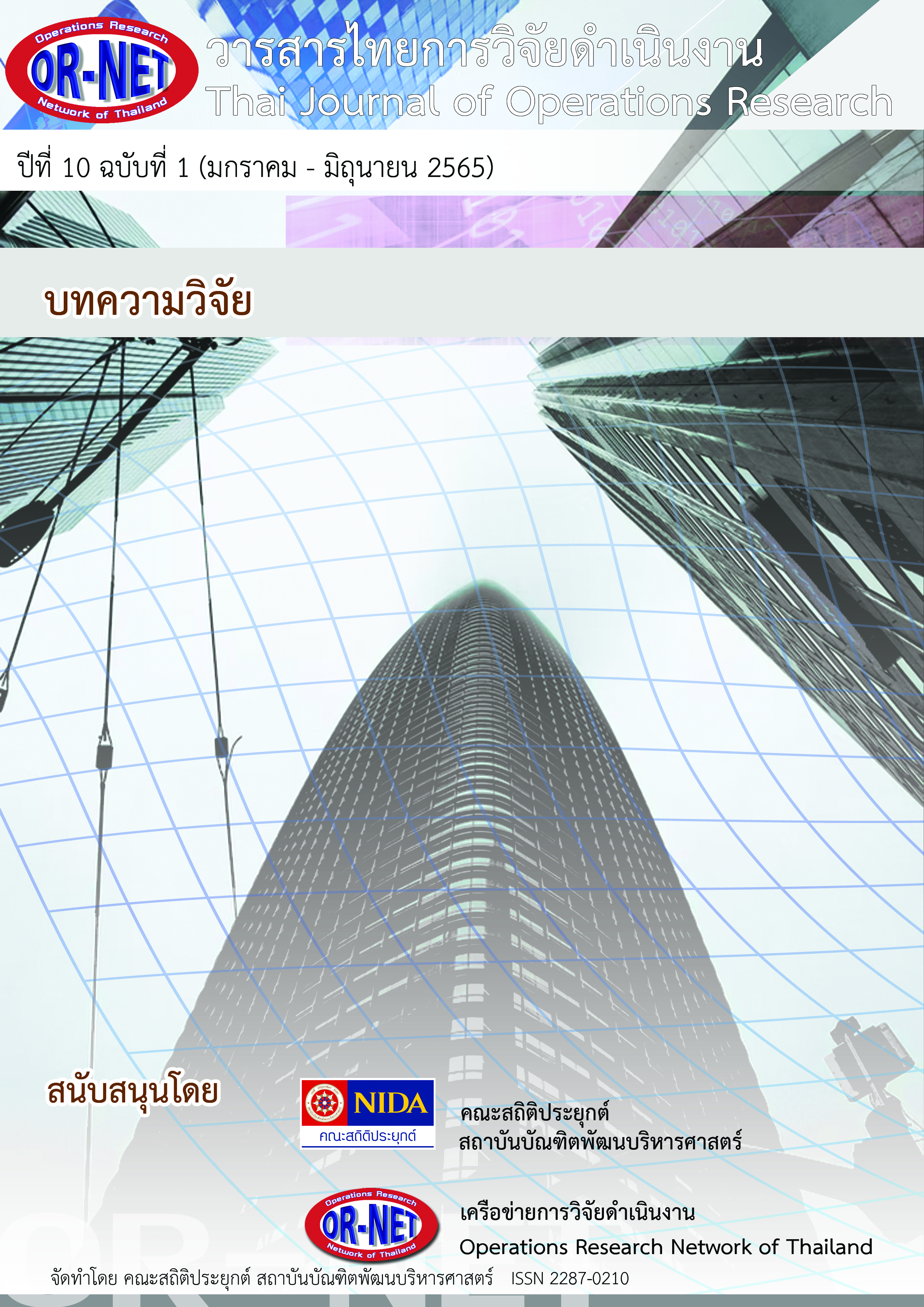ตัวแบบสินค้าคงคลังสองระดับเมื่อมีความต้องการสินค้าไม่แน่นอน
คำสำคัญ:
ตัวแบบสินค้าคงคลังสองระดับ, ความต้องการสินค้าไม่แน่นอน, เมตาฮิวริสติกบทคัดย่อ
งานวิจัยนี้มีวัตถุประสงค์เพื่อพัฒนาตัวแบบสินค้าคงคลังสองระดับกรณีที่ความต้องการสินค้าไม่แน่นอนและเปรียบเทียบวิธีการหาคำตอบเหมาะสุดของตัวแบบโดยใช้วิธีการค้นหาคำตอบแบบอัลกอลิทึมแมงปอ (Dragonfly algorithms; DA) วิธีกลุ่มอนุภาค(Particle swarm optimization ; PSO) และอัลกอลิทึมค้างคาว (Bat algorithm ; BA) ศึกษาภายใต้สถานการณ์สินค้าสองรายการมีความต้องการสินค้าที่เท่ากัน และไม่เท่ากัน โดยมีพารามิเตอร์ที่ศึกษาได้แก่ รอบของการค้นหาคำตอบ จำนวนสินค้ารายการที่บรรจุในแต่ละแพ็คเก็จ ราคาสินค้าต่อหน่วย ค่าใช้จ่ายต่อหน่วยในการจัดส่งสินค้า ค่าใช้จ่ายต่อหน่วยเนื่องจากสินค้าไม่พอจำหน่าย ค่าใช้จ่ายในการจัดซื้อ ค่าใช้จ่ายในการสั่งผลิต ค่าใช้จ่ายในการถือครองสินค้าต่อหน่วยต่อหน่วยเวลาของผู้ขาย ค่าใช้จ่ายในการถือครองสินค้าต่อหน่วยต่อหน่วยเวลาของผู้ซื้อ ประสิทธิภาพของการค้นหาคำตอบพิจารณาจากการลู่เข้าหาคำตอบที่เหมาะสุดของแต่ละวิธี ผลการวิจัยพบว่ากรณีที่ใช้รอบของการค้นหาคำตอบน้อยกว่า 50 มีหลายกรณีที่วิธี PSO ให้คำตอบที่ต่ำที่สุดแต่ถ้าเพิ่มจำนวนรอบของการค้นหาคำตอบพบว่า วิธี DA ให้คำตอบที่ดีกว่าวิธีอื่นและเริ่มเสถียรเมื่อจำนวนรอบมากกว่าหรือเท่ากับ 50 ในขณะที่วิธี PSO จะเริ่มเสถียรที่ จำนวนรอบของการค้นหาคำตอบเป็น 300 สำหรับวิธี BA .ให้คำตอบที่ด้อยกว่าวิธีอื่นทุกกรณี
เอกสารอ้างอิง
วราภรณ์ พกนนท์, ปวีณา เชาวลิตวงศ์ และนระเกณฑ์ พุ่มชูศรี, “นโยบายการเติมเต็มร่วมแบบสามารถจัดหาได้ สำหรับระบบแบบสองระดับ ภายใต้การศึกษาระยะเวลานำ”, วารสารวิศวกรรมศาสตร์, ปีที่ 5, ฉบับที่ 2, น. 27-47, 2557.
P. Yang, and L. Zeng, “Model and Method for Two-Echelon Location Routing Problem with Time Constraints in City Logistics”, Mathematical Problem in Engineering, vol. 2018, Article ID 2549713, 9 pages, 2018.
จารุมาศ แสงสว่าง และ วุฒิชัย ศรีโสดาพล, “ตัวแบบสินค้าคงคลังแบบสองระดับที่มีเวลานำและ การคืนสินค้าขึ้นอยู่กับความต้องการสินค้า”, วารสารวิทยาศาสตร์บูรพา, ปีที่ 22, ฉบับที่ 2, น. 145-153, 2560.
H. Sadjady and H. Davoudpour, “Two-echelon, Multi-commodity Supply Chain Network Design with Mode Selection Lead-times and Inventory Costs”, Computers & Operations Research, Vol. 39, pp. 1345-1354, 2012.
M.G. Samani and S.M. Hosseimi-Motlahg, “A Hybrid Algorithm for a Two-Echelon Location-routing Problem with Simultaneous Pickup and Delivery under Fuzzy Demand”, International Journal of Transportation Engineering vol.5, no.1, pp. 59-85, 2017.
A. Mahmoodi, A. Haji and A. Haji, “A two-echelon Inventor Model with Perishable Items and Lost Sales”, Scientia Iranic E Z2016X, vol.23 no.5, pp.2277-2286, 2016.
M. Seifbarghy, M. m. Kalani, M. Hemmati, A discrete Particle Swarm Optimization Algothm with Local Search for a Production-based Two-echelon Single-vendor Multiple-buyer Supply Chain”, Journal of Industrial Engineering Internationalม vol. 12, pp. 29-43, 2016.
ศิริรัตน์ กะการดี และ ศิรประภา มโนมัธย์, “การเปรียบเทียบประสิทธิภาพวิธีการหาค่าเหมาะสุดแบบกลุ่มอนุภาคและวิธีแบทสำหรับตัวแบบสินค้าคงคลัง 3 ระดับขั้น”, วารสารไทยการวิจัยดำเนินงาน, ปีที่ 8 ฉบับที่ 1, น.11-19, 2563.
A. A. Taleizadeh, S.T.A. Niaki, N. Shafii, R.G. Meibodi and A. Jabbarzadeh, “A Particle Swarm Optimization Approach for Constraint Joint Single Buyer-single Vendor Inventory Problem with Changeable Lead Time and (r,Q) Policy in Supply Chain”, International Advanced Manufacturing Technology, vol 51, pp.1209-1223, 2010.
S. Mirjalili “Dragonfly algorithm: a New Meta-heuristic Optimization Techniquefor Solving Single-objective, Discrete, and Multi-objective Problems”, Neural Comput & Applic, vol. 27 pp. 1053-1073, 2016.
Y. Meraihi, A. R.-Cherif, D. Acheli and M. Mahseur, “Dragonfly algorithm: a comprehensive review and applications”, Neural Computing and Applicationsvol. 32, pp.16625-16646, 2020.
E. O. Wilson, Sociobiology: The New Synthesis, Cambridge: Belknap Press, 1975.
J. Kennedy, R. Eberhart, “Particle Swarm Optimization”, Proceedings of the IEEE International Conference on Neural Networks, Perth, Australia, pp. 1942-1945, 1995.
X.S. Yang, “A New Metaheuristic Bat–Inspired Algorithm in J.R. González, D.A. Pelta, C. Cruz, G. Terrazas, and N. Krasnogor (eds.),” Nature Inspired Cooperative Strategies for Optimization Studies in Computational Intelligence., Vol. 284, pp. 65-74, 2010.
L. S. Riza, M. B. A. Prabowo, E. Junaeti, A. G. Abdullah and K. A. Fariza, “Development and Experimentation of R Package “metaheuristicOpt” on Continuous Optimization”, Journal of Engineering Science and Technology, vol. 16, no. 2, pp.1006 – 1018, 2021.
ดาวน์โหลด
เผยแพร่แล้ว
รูปแบบการอ้างอิง
ฉบับ
ประเภทบทความ
สัญญาอนุญาต

อนุญาตภายใต้เงื่อนไข Creative Commons Attribution-NonCommercial-NoDerivatives 4.0 International License.




